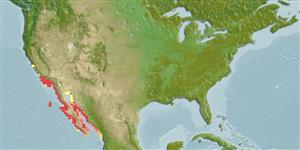Common names from other countries
>
Eupercaria/misc (Various families in series Eupercaria) >
Labridae (Wrasses)
Etymology: Semicossyphus: Greek, semi = half + Greek, kossyphos, -ou = a kind of fish (Ref. 45335).
More on author: Ayres.
Environment: milieu / climate zone / depth range / distribution range
Ökologie
seewasser riff-verbunden; tiefenbereich 0 - 55 m (Ref. 9311), usually 3 - 30 m (Ref. 9311). Subtropical; 37°N - 22°N, 123°W - 106°W
Eastern Pacific: Monterey Bay in California, USA to Guadalupe Island (off northern central Baja California) and Gulf of California.
Size / Gewicht / Alter
Maturity: Lm ? range ? - ? cm
Max length : 91.0 cm TL Männchen/unbestimmt; (Ref. 2850); max. veröff. Gewicht: 16.0 kg (Ref. 2850); max. veröff. Alter: 53 Jahre (Ref. 56049)
Prefer rocky bottom, particularly in kelp beds. Often feed on hard-shelled organisms such as sea urchins, mollusks, lobsters and crabs. Spawning occur during the summer and the eggs are pelagic (Ref. 9311). Live to more than 50 years of age. Each individual functions first as a female but changes to a male at a length of about 30 cm. Pelagic spawners (Ref. 56049). Flesh is white, of good quality and marketed fresh (Ref. 9311). The large teeth can cause serious bite wounds.
A diandric species (Ref. 55367). Transforms to a male at length of about 30.1 cm TL and 7.9 years of age (Ref. 55367). Forms leks during breeding (Ref. 55367). Pelagic spawner (Ref. 56049).
Eschmeyer, W.N., E.S. Herald and H. Hammann, 1983. A field guide to Pacific coast fishes of North America. Boston (MA, USA): Houghton Mifflin Company. xii+336 p. (Ref. 2850)
IUCN Rote Liste Status (Ref. 130435)
CITES (Ref. 128078)
Not Evaluated
Bedrohung für Menschen
Traumatogenic (Ref. 13513)
Nutzung durch Menschen
Fischereien: kommerziell; Sportfisch: ja; Aquarium: Kommerziell
Tools
Zusatzinformationen
Download XML
Internet Quellen
Estimates based on models
Preferred temperature (Ref.
115969): 16.6 - 22.9, mean 21.2 (based on 30 cells).
Phylogenetic diversity index (Ref.
82804): PD
50 = 0.6250 [Uniqueness, from 0.5 = low to 2.0 = high].
Bayesian length-weight: a=0.00955 (0.00456 - 0.02002), b=3.06 (2.89 - 3.23), in cm Total Length, based on LWR estimates for this (Sub)family-body shape (Ref.
93245).
Trophic level (Ref.
69278): 3.6 ±0.43 se; based on food items.
Widerstandsfähigkeit (Ref.
120179): sehr niedrig, Verdopplung der Population dauert mehr als 14 Jahre. (tmax=53; tm=5; Fec=300,000).
Fishing Vulnerability (Ref.
59153): Moderate to high vulnerability (55 of 100).
Climate Vulnerability (Ref.
125649): Very high vulnerability (78 of 100).
